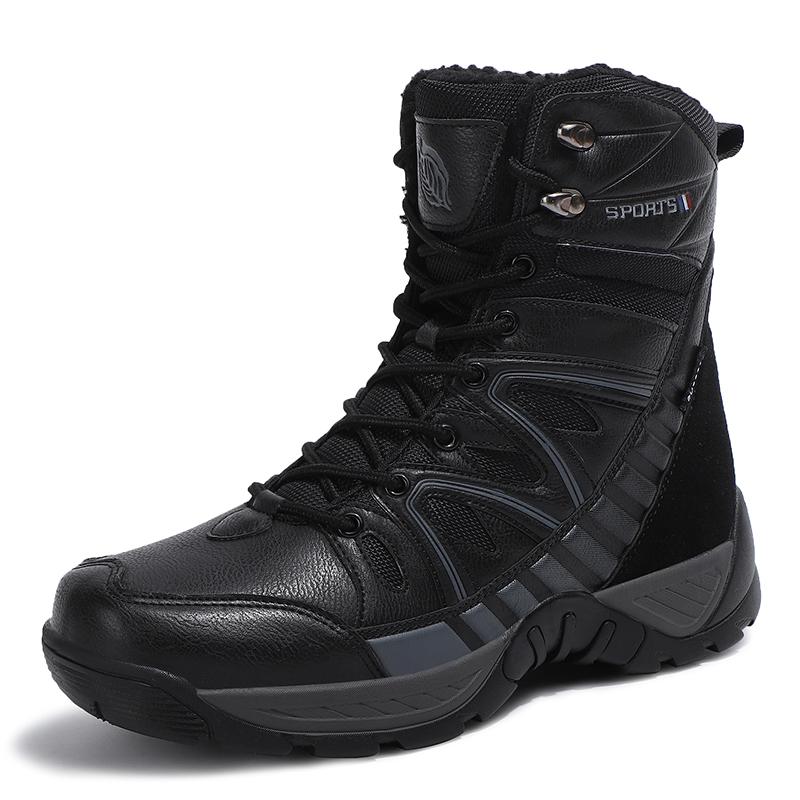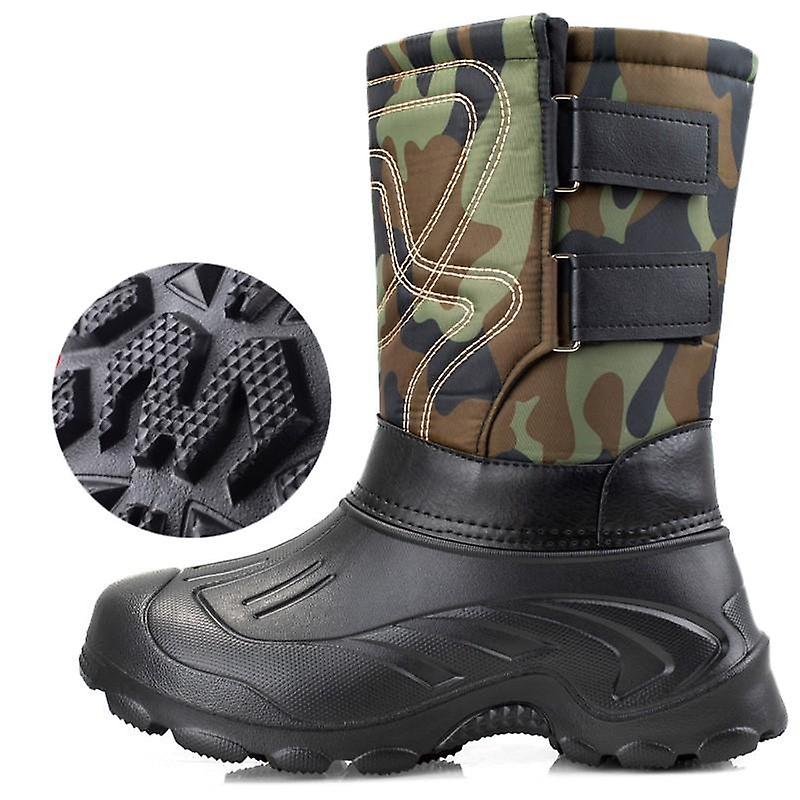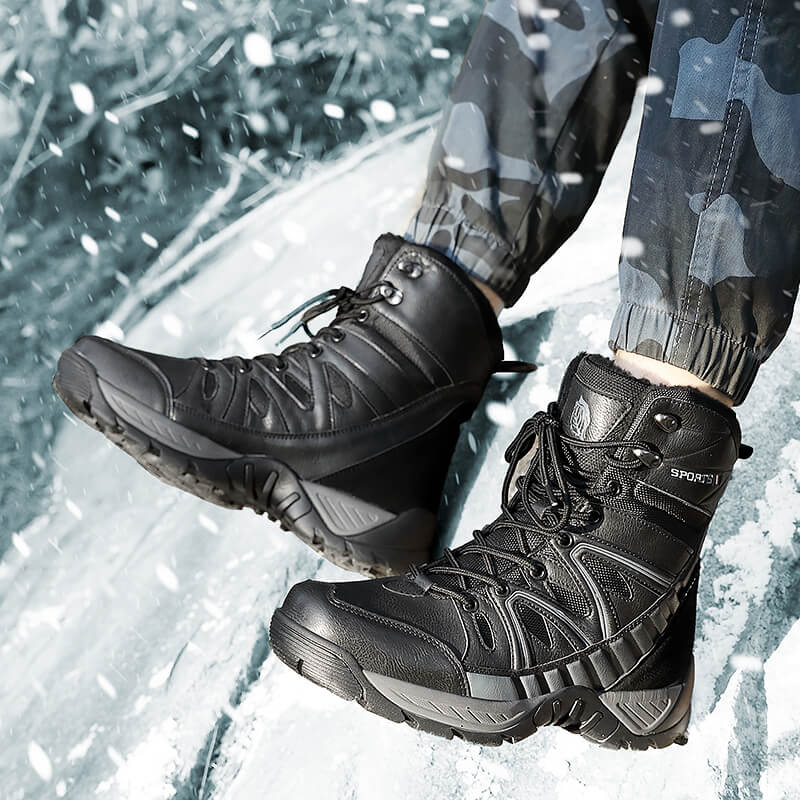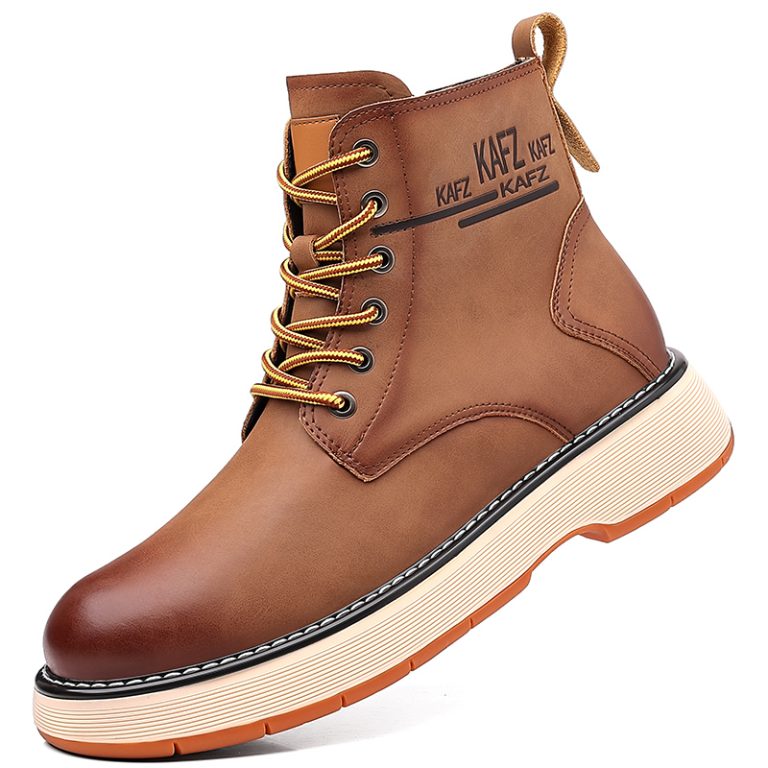Introduction to Fishing Boots
Fishing boots for men are essential gear for anglers, providing protection, comfort, and traction during fishing expeditions. Whether wading through rivers, standing on slippery rocks, or enduring hours in a boat, the right pair of fishing boots can enhance performance and enjoyment. In this comprehensive guide, we explore the different types of fishing boots available, their features, and considerations for choosing the best pair to suit your needs.

Types of Fishing Boots
1. Wading Boots
Wading boots are designed for anglers who spend time in rivers, streams, or lakes, where traction and waterproofing are crucial. These boots typically have felt or rubber soles that provide grip on slippery surfaces. Felt soles are preferred for their superior traction on rocks and algae-covered riverbeds, while rubber soles offer durability and protection against sharp objects. Some wading boots come with interchangeable soles, allowing anglers to adapt to different fishing environments.
2. Waterproof Boots
Waterproof fishing boots are ideal for anglers who fish in wet conditions or during inclement weather. These boots are typically made from materials such as neoprene or rubber, which provide insulation and keep feet dry. Neoprene boots are lightweight and offer thermal protection, making them suitable for cold-water fishing. Rubber boots, on the other hand, are durable and easy to clean, making them a practical choice for muddy or rainy conditions.
3. Boat Boots
Boat boots are designed for anglers who primarily fish from boats or docks. These boots prioritize comfort and mobility, with features like lightweight construction and non-marking soles that won’t scuff boat decks. Boat boots may have slip-resistant treads to provide stability on wet surfaces, ensuring safety while moving around on deck. They are often made from quick-drying materials to prevent water retention and maintain comfort throughout the day.
Features to Consider
When choosing fishing boots, several features should be considered to ensure they meet your specific needs and fishing conditions.
1. Material and Construction
The material of fishing boots determines their durability, waterproofing, and insulation properties. Neoprene offers excellent warmth and flexibility, making it suitable for cold-water fishing. Rubber is durable and resistant to abrasion, ideal for rugged terrains. Consider the construction quality, such as seam sealing and reinforcements, to ensure longevity and protection against water ingress.
2. Traction and Stability
Traction is essential for navigating slippery surfaces encountered while fishing. Look for boots with grippy soles, whether they are felt, rubber, or a combination. Felt soles excel on smooth rocks and algae-covered riverbeds, while rubber soles provide durability and traction on various surfaces. Some boots feature lug patterns or cleats for enhanced grip in challenging conditions.
3. Comfort and Fit
Comfortable fishing boots allow anglers to focus on fishing without discomfort or fatigue. Look for boots with cushioned insoles, adequate ankle support, and a secure fit. Boots should provide enough room for thick socks if fishing in cold weather, without being too loose or restrictive. Consider the weight of the boots, as lighter options may be more comfortable for extended wear.
4. Insulation and Breathability
Insulated boots are essential for fishing in cold water or during winter months. Neoprene boots provide thermal insulation while remaining lightweight and flexible. Breathability is crucial to prevent sweat buildup and keep feet dry and comfortable throughout the day. Some boots feature moisture-wicking linings or breathable materials to enhance comfort in varying weather conditions.
Maintenance and Care
Proper maintenance extends the lifespan of fishing boots and ensures their performance remains optimal over time.
1. Cleaning
After each use, rinse off mud, dirt, and saltwater from the boots using clean water. Use a soft brush to remove debris from seams and crevices. Avoid using harsh chemicals or detergents that could damage the material or affect waterproofing.
2. Drying
Allow boots to air dry thoroughly before storing them. Remove insoles if possible to expedite drying. Avoid placing boots near direct heat sources, as excessive heat can cause materials to deteriorate or shrink.
3. Storage
Store fishing boots in a cool, dry place away from direct sunlight. Stuff boots with newspaper or boot shapers to maintain their shape and prevent odor buildup. Periodically treat leather or rubber boots with appropriate conditioners to maintain suppleness and prevent cracking.

The Benefits of Fishing Boots for Men
Enhanced Comfort and Support
One of the most important benefits of fishing boots is the enhanced comfort and support they provide. Fishing often requires long hours of standing and walking on uneven and slippery surfaces. Quality fishing boots ensure that your feet remain comfortable throughout the day, reducing fatigue and enhancing your overall fishing experience.
Key Advantages
- Cushioned Insoles: Many fishing boots come with cushioned insoles that provide excellent support and comfort. These insoles help absorb impact and reduce pressure on your feet, allowing you to fish for extended periods without discomfort.
- Arch Support: Proper arch support is essential for maintaining proper foot alignment and reducing strain on your arches. Fishing boots with built-in arch support help prevent foot fatigue and discomfort, ensuring that you remain comfortable throughout the day.
- Ankle Support: Fishing boots often feature reinforced ankle support to provide stability and prevent ankle injuries. This support is particularly important when walking on uneven surfaces or wading in water.
The enhanced comfort and support provided by fishing boots make them an essential piece of gear for any angler, ensuring that your feet remain comfortable and protected throughout your fishing adventures.
Superior Traction and Stability
Fishing often involves navigating slippery and uneven surfaces, such as riverbanks, rocky shores, and muddy terrain. Quality fishing boots offer superior traction and stability, ensuring that you remain steady and secure in various environments.
Key Advantages
- Non-Slip Soles: Many fishing boots feature non-slip soles that provide excellent grip on wet and slippery surfaces. These soles help prevent slips and falls, ensuring that you remain steady and secure while fishing.
- Sturdy Tread Patterns: Fishing boots often have sturdy tread patterns that enhance traction and provide stability on uneven terrain. These tread patterns help improve your footing and prevent accidents, allowing you to fish with confidence.
- Rubber Outsoles: Rubber outsoles are a common feature of fishing boots, providing durability and traction on various surfaces. These outsoles are designed to withstand the rigors of fishing environments, ensuring that your boots remain in good condition.
The superior traction and stability provided by fishing boots ensure that you remain steady and secure in various fishing environments, reducing the risk of slips and falls.
Protection from Water and Elements
Fishing often involves exposure to water and various elements, such as mud, debris, and sharp objects. Fishing boots provide essential protection from these elements, ensuring that your feet remain dry, safe, and comfortable.
Key Advantages
- Waterproof Materials: Many fishing boots are made from waterproof materials, such as neoprene and rubber, that keep your feet dry in wet conditions. These materials provide a barrier against water, preventing it from seeping into your boots.
- Sealed Seams: Fishing boots often feature sealed seams that prevent water from entering through the stitching. This design ensures that your feet remain dry, even when wading in water.
- Reinforced Toe and Heel: Fishing boots often have reinforced toe and heel caps that provide additional protection from sharp objects and debris. These reinforced areas help prevent injuries and ensure that your boots remain durable.
The protection provided by fishing boots from water and various elements ensures that your feet remain dry, safe, and comfortable, allowing you to fish with confidence.
Durability and Longevity
Fishing boots are designed to withstand the rigors of fishing environments, ensuring that they remain durable and long-lasting. Investing in quality fishing boots ensures that you have reliable footwear that provides long-term performance.
Key Advantages
- High-Quality Materials: Fishing boots are made from high-quality materials, such as rubber, neoprene, and durable textiles, that withstand the wear and tear of fishing environments. These materials ensure that your boots remain in excellent condition, even with regular use.
- Reinforced Construction: Many fishing boots feature reinforced construction, such as double stitching and bonded seams, that enhance their durability and longevity. This construction ensures that your boots remain strong and reliable over time.
- Easy Maintenance: Fishing boots are designed to be easy to clean and maintain, ensuring that they remain in good condition. Proper maintenance practices can further extend the lifespan of your boots, providing long-term performance.
The durability and longevity provided by fishing boots ensure that you have reliable footwear that provides long-term performance, making them a valuable investment in your fishing gear.
Different Types of Fishing Boots for Men
Wading Boots
Wading boots are a popular type of fishing boots designed specifically for anglers who wade in water. These boots provide excellent traction, support, and protection, making them ideal for river and stream fishing.
Key Characteristics
- Waterproof and Quick-Drying Materials: Wading boots are made from waterproof and quick-drying materials, ensuring that your feet remain dry and comfortable in wet conditions. These materials prevent water from seeping into your boots and dry quickly after use.
- Sturdy Tread Patterns: Wading boots feature sturdy tread patterns that provide excellent traction on slippery and uneven surfaces. These tread patterns help improve your footing and prevent slips and falls.
- Reinforced Ankle Support: Wading boots often have reinforced ankle support to provide stability and prevent ankle injuries. This support is particularly important when walking on uneven terrain or wading in water.
Common Uses
- River and Stream Fishing: Wading boots are ideal for river and stream fishing, providing the traction, support, and protection you need when wading in water. Their waterproof design ensures that your feet remain dry and comfortable.
- Fly Fishing: Fly fishing often involves wading in streams and rivers, making wading boots an essential piece of gear. Their sturdy construction and excellent traction make them suitable for various fishing environments.
- Saltwater Fishing: Wading boots are also suitable for saltwater fishing, providing protection from sharp objects and slippery surfaces. Their durable materials ensure that they withstand the rigors of saltwater environments.
Wading boots provide the traction, support, and protection needed for river and stream fishing, making them a popular choice for anglers who wade in water.
Rubber Boots
Rubber boots are another popular type of fishing boots known for their waterproof design and durability. These boots provide excellent protection from water and various elements, making them suitable for a wide range of fishing environments.
Key Characteristics
- Waterproof Construction: Rubber boots are made from waterproof materials, such as rubber and neoprene, that keep your feet dry in wet conditions. These materials provide a barrier against water, preventing it from seeping into your boots.
- Reinforced Toe and Heel: Rubber boots often have reinforced toe and heel caps that provide additional protection from sharp objects and debris. These reinforced areas help prevent injuries and ensure that your boots remain durable.
- Non-Slip Soles: Rubber boots feature non-slip soles that provide excellent grip on wet and slippery surfaces. These soles help prevent slips and falls, ensuring that you remain steady and secure while fishing.
Common Uses
- Lake and Pond Fishing: Rubber boots are ideal for lake and pond fishing, providing the waterproof protection needed to keep your feet dry. Their durable construction ensures that they withstand the rigors of fishing environments.
- Mud and Swamp Fishing: Rubber boots are suitable for fishing in muddy and swampy environments, providing protection from mud, debris, and sharp objects. Their non-slip soles ensure that you remain steady and secure on slippery surfaces.
- Cold Weather Fishing: Rubber boots are also suitable for cold weather fishing, providing insulation and protection from cold water and elements. Their waterproof design ensures that your feet remain dry and warm.
Rubber boots provide the waterproof protection needed for various fishing environments, making them a popular choice for anglers who fish in wet and muddy conditions.
Hip Waders
Hip waders are a type of fishing boots that extend up to the hips, providing full leg coverage and protection from water. These boots are ideal for anglers who wade in deeper water, offering excellent protection and comfort.
Key Characteristics
- Waterproof Design: Hip waders are made from waterproof materials, such as rubber and neoprene, that keep your feet and legs dry in wet conditions. These materials provide a barrier against water, preventing it from seeping into your boots.
- Adjustable Straps: Hip waders often feature adjustable straps that allow for a customized and secure fit. These straps ensure that the waders stay in place and provide consistent coverage and protection.
- Reinforced Construction: Hip waders have reinforced construction, such as double stitching and bonded seams, that enhance their durability and longevity. This construction ensures that the waders remain strong and reliable over time.
Common Uses
- River and Stream Fishing: Hip waders are ideal for river and stream fishing, providing full leg coverage and protection needed when wading in deeper water. Their waterproof design ensures that your feet and legs remain dry and comfortable.
- Wetland and Marsh Fishing: Hip waders are suitable for fishing in wetlands and marshes, providing protection from water, mud, and debris. Their reinforced construction ensures that they withstand the rigors of wetland environments.
- Fly Fishing: Fly fishing often involves wading in streams and rivers, making hip waders an essential piece of gear. Their full leg coverage and excellent traction make them suitable for various fishing environments.
Hip waders provide the full leg coverage and protection needed for wading in deeper water, making them a popular choice for anglers who fish in rivers, streams, and wetlands.
Chest Waders
Chest waders are a type of fishing boots that extend up to the chest, providing full-body coverage and protection from water. These boots are ideal for anglers who wade in deep water, offering maximum protection and comfort.
Key Characteristics
- Waterproof Design: Chest waders are made from waterproof materials, such as rubber, neoprene, and durable textiles, that keep your feet and body dry in wet conditions. These materials provide a barrier against water, preventing it from seeping into your boots.
- Adjustable Straps and Belts: Chest waders often feature adjustable straps and belts that allow for a customized and secure fit. These straps and belts ensure that the waders stay in place and provide consistent coverage and protection.
- Reinforced Construction: Chest waders have reinforced construction, such as double stitching and bonded seams, that enhance their durability and longevity. This construction ensures that the waders remain strong and reliable over time.
Common Uses
- River and Stream Fishing: Chest waders are ideal for river and stream fishing, providing full-body coverage and protection needed when wading in deep water. Their waterproof design ensures that your feet and body remain dry and comfortable.
- Wetland and Marsh Fishing: Chest waders are suitable for fishing in wetlands and marshes, providing protection from water, mud, and debris. Their reinforced construction ensures that they withstand the rigors of wetland environments.
- Fly Fishing: Fly fishing often involves wading in streams and rivers, making chest waders an essential piece of gear. Their full-body coverage and excellent traction make them suitable for various fishing environments.
Chest waders provide the full-body coverage and protection needed for wading in deep water, making them a popular choice for anglers who fish in rivers, streams, and wetlands.

How to Care for and Maintain Fishing Boots for Men
Cleaning and Maintenance
Proper cleaning and maintenance are essential for keeping your fishing boots in excellent condition. Regular care ensures that the fishing boots remain clean, comfortable, and durable.
Key Steps
- Clean the Boots: Use a damp cloth and mild soap to clean the surface of your fishing boots for men. Avoid using harsh chemicals that can damage the materials. For stubborn stains, use a cleaner specifically designed for the materials of your boots.
- Dry the Boots: After cleaning, allow the fishing boots to air dry naturally. Avoid using direct heat sources like heaters or hair dryers, as excessive heat can damage the materials and affect the fit.
- Condition the Boots: If your fishing boots for men are made from leather, apply a leather conditioner to keep the leather soft and supple. Conditioning the leather helps prevent it from drying out and cracking, ensuring that the boots remain in good condition.
Proper cleaning and maintenance ensure that your fishing boots for men remain clean, comfortable, and durable, extending their lifespan.
Storing Your Boots
Proper storage is crucial for maintaining the shape and quality of your fishing boots. Appropriate storage practices protect the boots from damage and ensure they remain in good condition.
Key Steps
- Clean Before Storing: Always clean your fishing boots before storing them. Removing dirt and stains prevents the materials from deteriorating over time.
- Use Boot Trees: If your fishing boots are made from leather, insert boot trees into your boots to maintain their shape. Boot trees help prevent the leather from creasing and collapsing, ensuring that the boots retain their form.
- Store in a Cool, Dry Place: Store your fishing boots for men in a cool, dry place away from direct sunlight and humidity. Excessive heat and moisture can damage the materials and affect the fit.
Conclusion
Choosing the fishing boots for men is essential for comfort, safety, and performance while angling. Consider the fishing environment, weather conditions, and personal preferences when selecting between wading boots, waterproof boots, or boat boots. Pay attention to features such as material, traction, comfort, and maintenance requirements to ensure your boots withstand the rigors of fishing expeditions. With proper care and consideration, a good pair of fishing boots will enhance your fishing experience and provide reliable support for years to come.

